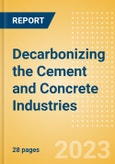Summary
The cement industry is a significant global emitter, accounting for 8% of global emissions (the largest within the construction industry). To incentivize emission reductions, the sector has set bold net-zero targets. However, they remain far off track. Cement is a hard to abate sector due to the large global demand for new construction, particularly in rapidly urbanizing countries. Due to this requirement, it is essential the sector engages with a range of decarbonization technologies to tackle their resulting emissions. Decarbonization technologies include supplementary cementitious material, alternative fuels, carbon capture, utilisation, and storage, and green concrete, which are in varying stages of development and implementation. All face issues of cost, and some face raw material shortages. Cement production cannot be fully electrified. Instead, the sector will need to increase the proportion of alternative fuels used to replace coal and reduce carbon emissions. Carbon capture technology is now in early stages of being implemented at some plants, working to offset their overall emissions, while some electrifiable operations should use renewable energy. New technologies have been demonstrated to show ways of making concrete net carbon negative, which while still in the very early stages, could be vital in transforming the industry. Cost is currently prohibitive, but the technologies could be a valuable resource in achieving the ambitious but essential net zero targets.While cement and concrete have historically been sectors that are well known for their ‘hard to abate’ emissions, the pressure to decarbonize is rising rapidly. This report assesses the sector’s current emissions footprint and its emissions reduction targets. It also explores the potential and limitations of the cement sector’s foremost decarbonization technologies: clinker substitution, alternative fuels, CCUS, and carbon negative concrete.
- Identify the market trends of energy transition technologies within the chemical industry
- Develop market insight into current rates of technology adoption in chemicals and the factors that will shape the sectors’ decarbonization.
- Identify the companies most active within CCUS, alternative fuels, alternative clinker, and carbon negative concrete in the chemical industry
Highlights:
- On average, the cement industry accounts for 8% of global greenhouse gas emissions, more than any country other than the US or China.
- The majority of CO2 emissions from cement come from the calcination process, where limestone is heated to produce calcium oxide
- Decarbonization costs will reduce as renewable energy scales up and becomes more affordable. However, retrofitting cement plants with carbon capture technology will remain expensive.
- Calcined clay emits 74% less CO2 than traditional clinker, so can significantly reduce the carbon footprint of cement.
- The EU Innovation Fund has endorsed 8 large scale CCUS projects within the cement industry. Most are currently in the grant preparation stage, with plans to become operational before 2030
- Companies such as Holcim and CEMEX already have some plants running on almost 100% alternative fuel, and CEMEX has reached a 70% alternative fuel rate across its European plants.
Scope
- Current carbon footprint of cement
- Cement industry net zero targets
- Top cement companies emission reduction targets
- Top four technologies for decarbonizing cement
- Challenges of decarbonization
- Leading companies decarbonizing cement
- CCUS outlook for cement
- Renewable and synthetic fuel outlook for cement
- Carbon negative concrete
Reasons to Buy
- Identify the market trends of energy transition technologies within the chemical industry
- Develop market insight into current rates of technology adoption in chemicals and the factors that will shape the sectors’ decarbonization.
- Identify the companies most active within CCUS, alternative fuels, alternative clinker, and carbon negative concrete in the chemical industry
Table of Contents
- Executive Summary
- Cement and concrete carbon emissions
- Cement and concrete’s contribution to climate change
- Cement and concrete’s progress towards net-zero
- Introduction to decarbonization technologies
- Four key decarbonization technologies
Companies Mentioned (Partial List)
A selection of companies mentioned in this report includes, but is not limited to:
- Cement Roadstone Holdings
- Holcim Group
- Anhui Conch Cement Co. Ltd.
- Heidelberg Materials AG
- The Siam Cement Public Co Ltd
- CEMEX SAB de CV
- Grasim Industries Ltd
- UltraTech Cement Ltd
- Taiheiyo Cement Corporation
- Brimstone Energy
- Terra CO2 Technologies Ltd.
- Solidia Technologies
- ecoLocked GmbH
- BluePlanet Ltd.
- Ecocem Global
- CarbonCure Technologies
- BioZeroc Ltd
- Hoffman Green Cement Technologies SAS
- CarbonFree Chemicals Holdings LLC.








